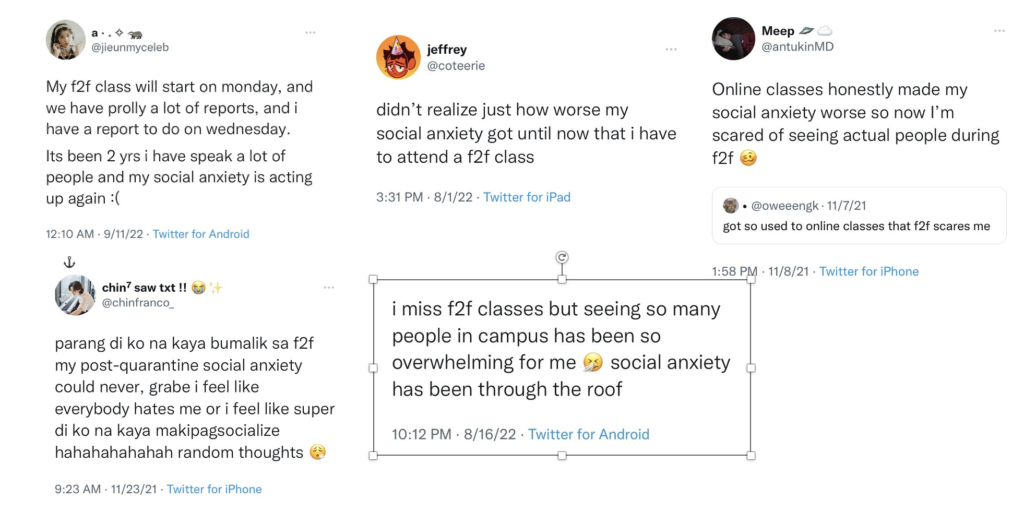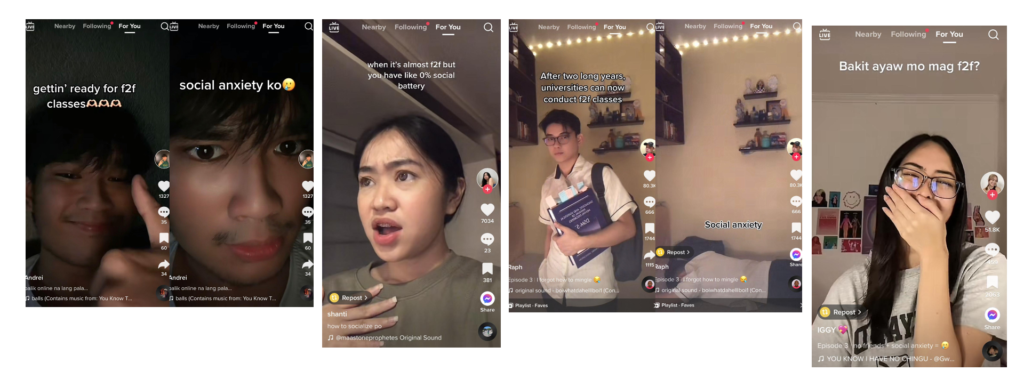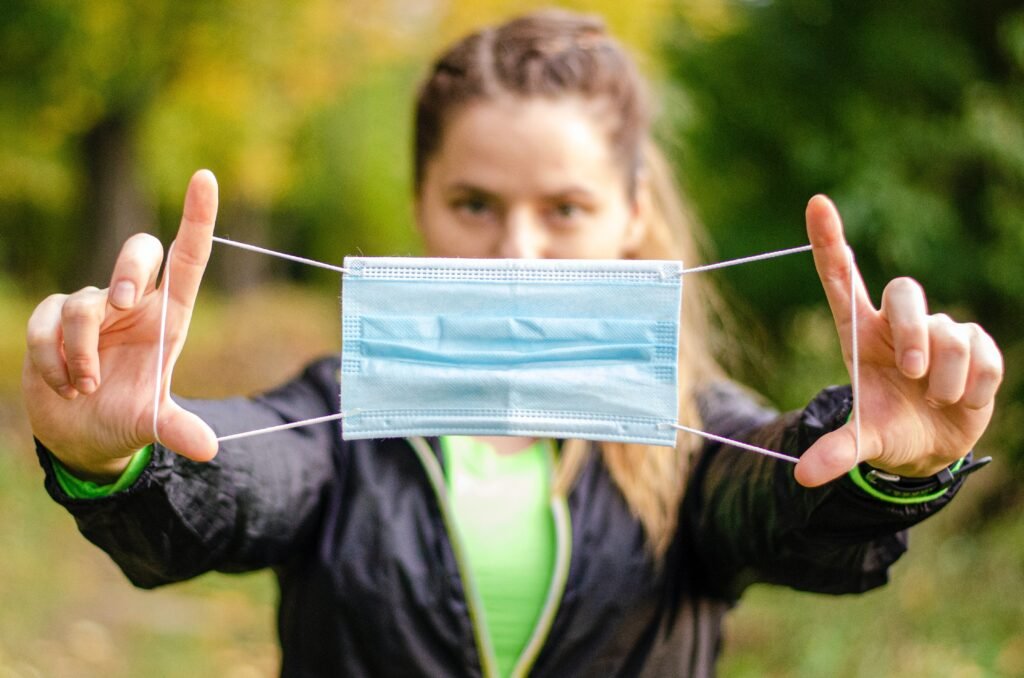By Mariane Gabrielle C. Cagalawan
At the beginning of the pandemic, wearing a face mask felt like a burden. But as schools reopen in the Philippines, it became a hiding cloak for students, protecting them from society more than it protects them from the virus.
After more than two years of COVID-19 lockdown, the Philippines reopened face-to-face classes last August 2022, with a target to operate at full capacity in November. The country, which was included in the world’s longest lockdowns, was one of the last ones to open schools. According to reports, the two-year distance learning has affected the quality of education in the country with concerns on the competency of students.
However, aside from the educational crisis, there has also been an internal issue that the country and schools may have missed as they resume face-to-face classes – post-pandemic social anxiety.
When the reopening of schools were reported on the internet, it was a surprise that the excitement of students did not fully dominate the online platforms. Instead, posts about social anxiety, stress, and fear about going back to school were all over TikTok, Facebook, and Twitter. Students expressed their worry on making friends, showing up in person, and experiencing panic attacks during classes.


https://www.tiktok.com/@andreifyppp/video/7130937480882294043
https://www.tiktok.com/@shantigirl_/video/7132390412857249051
https://www.tiktok.com/@andreifyppp/video/7130937480882294043
https://www.tiktok.com/@inggredd/video/7082701798573722906
Additionally, they shared their confusion on how the pandemic has drained their social battery until it started to develop into a crippling feeling of distress with fear of being judged or scrutinized in situations that are associated with showing up and having interactions with people. This involved intense fear of communicating with others with physical evidence such as blushing, sweating, and trembling voice, feeling held back to speak due to overthinking that one might humiliate oneself, and extreme anticipation before an activity or event.
These feelings may be something more than shyness. And when not managed, may affect other factors such as students’ well-being, relationship with others, and overall performance in school.
Why do we feel this?
Registered Psychometrician and Psychologist, Elizabeth A. Toledo, has taken the plunge and said that this is a normal feeling. It is alright to feel anxious or have difficulty sleeping at night before or a few days before the d-day.
Usually, when we experience change in our life, minor or major, our normal response is fear or anxiety. Anxiety is basically our human response to threat. We protect ourselves from possible things that might go wrong in relation to the change. In this instance, it is the shift from online to face-to-face classes, in the same way we may have also felt fear or anxiety when we transitioned from a face-to-face to online setup at the start of the pandemic.
The most possible root of this feeling is the comfort we built when we got used to the online set up. The pandemic made us utilize the internet more, making us think that our whole lives revolve around it. For most people, social anxiety comes from the thought of being judged by others. And probably, the biggest factor that can exacerbate these feelings is our experiences online where many are quick to judge. This can make us feel more conscious as we go back to face-to-face for we feel scared to experience such things in the real world.
Therefore, not all fear or anxiety is automatically a disorder, many will experience a certain amount of shyness at first, but will soon adjust and enjoy socializing, especially after a few face-to-face sessions. However, for others, they might feel a stronger impact. If you’re having recurrent panic attacks, pervasive thoughts, and persistent anxiety in your body that are beginning to affect your functioning, then that might indicate that you are already experiencing something “not normal” and it is time to seek professional help.
What should we do?
As someone experiencing post-pandemic social anxiety:
1. Be self-aware
Pay attention to your thoughts.. Ask yourself, “Why am I scared?” and “What am I afraid of?” and zoom in to the other emotions you feel that come with the anxiety. Are there hints of excitement or apprehension?
2. Do something about it
Once you are aware of how that social anxiety is manifesting and affecting you, then you can be able to address it appropriately.
For example, if you notice manifestations of social anxiety in your body, attend to it. If you have a hard time sleeping, you can try out different ways of making yourself sleep more comfortably. If your anxiety comes through raising thoughts, you can try externalizing it by writing down to get it out of your head or share it to another person like your friend or a family member.
Here are other day-to-day strategies we can use to cope up with social anxiety.
3. Practice
In socializing, we can always start with baby steps. We can practice social interaction with some of our close friends first, before immersing ourselves in bigger groups. If there’s an opportunity to interact with a smaller group you’re comfortable with, then you can practice with them first. It may sound weird, but doing a little practice can ease up the anxiety. Just like doing presentations, we feel more confident the next day when we know that we did a little rehearsal the night before.
Usually, the anticipation before an interaction is worse than the actual interaction itself. It can make you go, “That wasn’t bad as I thought it would be”. And maybe, would break all the ice and make you want to do it all over again, frequently.
As a teacher of a student experiencing post-pandemic social anxiety:
1. Extend patience and respect the students’ pace
As a teacher, if you notice your students experiencing difficulties interacting with others or performing in social gatherings, like reciting in class, do not force them to do such and respect every student’s pace. Also consider easing into face-to-face sessions when it comes to interacting with their co-learners and teachers.
2. Model
Model what you want your students to practice. If they see their teachers feeling anxious, there is a probability that they will adopt that anxiousness. Start with baby steps such as small talks to practice both of your communication skills. This way, students will be able to learn a thing or two on how to handle conversations.
As a parent, guardian, or friend:
1. Be an active listener
Listen not just to what your child or friend is saying, but also what they’re not saying. This is because their anxiety can hinder their putting of thoughts into words.
Sometimes, you mean well when giving advice and words of encouragement right away, but they may come off as invalidating at times and not helping the student as a result. Being an active listener involves all senses. Through it, you put effort by paying close attention and comprehending what others are trying to say without passing judgment. Their fear and anxiety should not be discounted as unreal or unimportant. To them, these feelings are real and impact their life. Respond to these emotions with curiosity and compassion, not criticism.
2. Encourage, don’t criticize
People who experience social anxiety are already over-critical of themselves. Criticizing your children or friends can already add up to the problem. Instead, help them build the courage to face what triggers their anxiety and encourage them to avoid hiding from social situations. But try to understand the limits their anxiety puts on them and provide a supportive environment as they gradually improve.
The COVID-19 pandemic instilled a big change in everyone’s life. People were confused, frustrated, and anxious. However, they found ways to cope with it. Therefore, the feelings you may experience as you enter another shift is something you must not blame yourself for.
Now, it is your responsibility to do something about it. But remember, that as you push yourself to walk out of your room and face the real world, there are people who can listen, understand, and help.
And you are not alone.

References
https://www.nimh.nih.gov/health/publications/social-anxiety-disorder-more-than-just-shyness
https://www.unicef.org/philippines/reopening-schools-safely
https://www.cedars-sinai.org/newsroom/managing-post-pandemic-social-anxiety/
https://www.verywellmind.com/coping-with-social-anxiety-disorder-3024836

